High-performance thermal management materials are essential for modern electronic devices to guarantee reliable operation, prevent overheating, and maintain peak performance. DuPont's Temprion family, Rogers Materials, AGC Materials, Arlon Materials, and Polyimide Materials are top choices for thermal management, offering exceptional heat transfer capabilities, high thermal conductivity, and low thermal expansion. Metal Core Materials and Advanced Thermal Management Materials provide superior thermal conductivity and efficient heat dissipation. Selecting the right material is vital, considering factors like peak temperature, frequency of temperature cycling, and thermal conductivity requirements. Dive deeper into the world of thermal management to discover more.
Key Takeaways
- DuPont's Temprion family offers exceptional heat transfer capabilities and is designed to manage heat from high-power components.
- Rogers Materials provide tailored thermal conductivity solutions ranging from 1.0 W/mK to 6.0 W/mK for high-power electronic applications.
- AGC Materials achieve high Tg values, ensuring thermal stability in demanding applications, and provide excellent thermal conductivity and low thermal expansion.
- Polyimide Materials guarantee consistent performance in demanding environments, with high thermal stability and excellent mechanical properties.
- Arlon Materials excel in high-power PCB applications, offering high-temperature insulation properties and CuClad laminates with glass conversion temperatures up to 230°C.
High Thermal Conductivity Materials
High thermal conductivity materials, such as those offered by DuPont's Temprion family, have emerged as an essential component in the thermal management of circuit boards, providing exceptional heat transfer capabilities and unrivaled thermal impedance and conductivity.
These materials are specifically designed to manage heat generated by high-power components, ensuring reliable performance and extending the lifespan of electronic devices.
The Temprion family, including Temprion EIF and OHS, offers superior thermal conductivity, making them an ideal choice for thermal interface materials in PCB materials.
The exceptional heat transfer capabilities of these materials enable efficient heat dissipation, reducing the risk of overheating and subsequent damage to sensitive electronic components.
Low CTE PTFE-Based Laminates
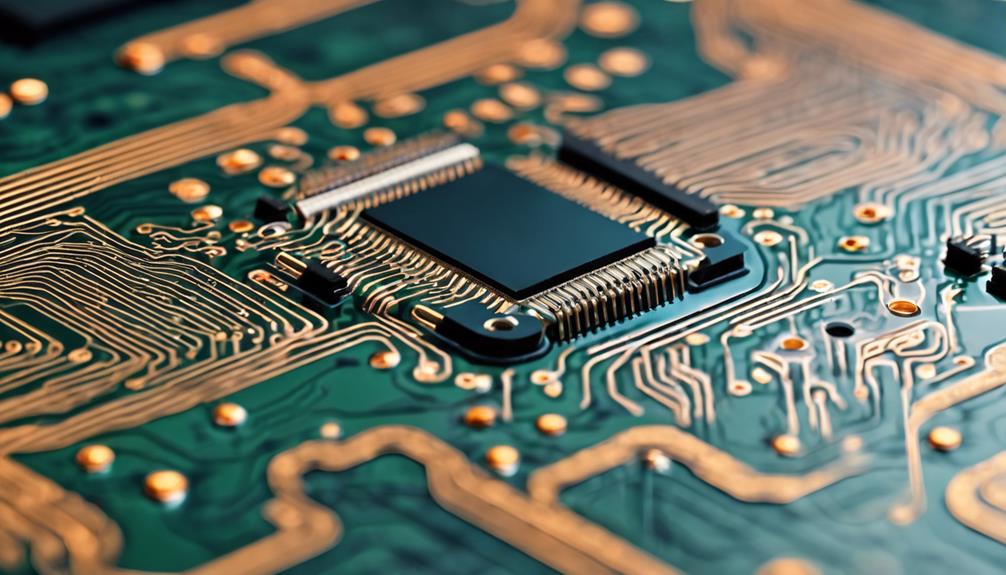
Incorporating low CTE PTFE-based laminates into high-speed applications allows for the preservation of signal integrity and minimizes the risk of thermal-induced failures. These laminates offer excellent thermal conductivity, making them an ideal choice for high-frequency PCB designs. The low coefficient of thermal expansion (CTE) reduces stress on copper features, guaranteeing stable performance in demanding thermal conditions.
PTFE-based materials are well-suited for high-temperature environments, providing superior performance and reliability. Selecting low CTE PTFE-based laminates guarantees stable performance, even in extreme thermal conditions. This is particularly important in high-speed applications where thermal management is critical.
By minimizing thermal-induced stress, these laminates help maintain signal integrity and prevent failures. The use of PTFE-based laminates, such as Rogers and Taconic, is widespread in high-frequency PCB designs due to their exceptional thermal conductivity and stability.
Rogers Materials for Thermal Management
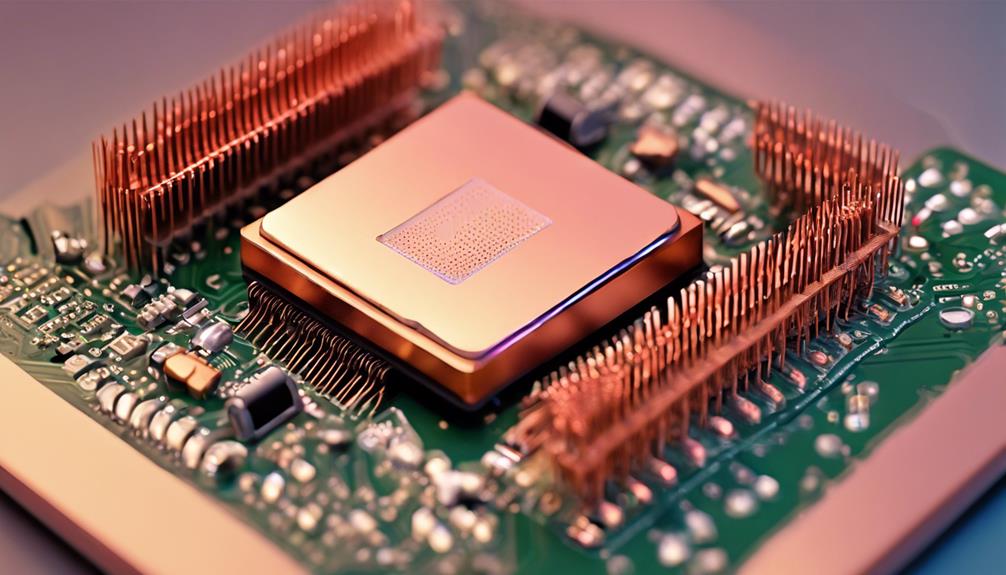
When it comes to Rogers materials for thermal management, several key factors come into play.
The thermal conductivity range of these materials is a vital consideration, as it directly impacts their ability to efficiently dissipate heat in high-power electronic designs.
Additionally, material durability factors and high-frequency performance also play essential roles in determining the overall effectiveness of Rogers materials in thermal management applications.
Thermal Conductivity Range
Rogers Corporation's thermal management materials boast a thermal conductivity range of 1.0 W/mK to 6.0 W/mK, enabling designers to select the most suitable material for their specific heat dissipation requirements. This extensive range allows for tailored solutions in high-power electronic applications, where efficient heat dissipation is essential.
The thermal conductivity range is particularly important in high-frequency circuit boards, where ideal operating temperatures must be maintained to guarantee reliable performance. Rogers' materials are designed to efficiently dissipate heat, guaranteeing the reliability and performance of demanding thermal environments.
By offering a range of thermal conductivity options, designers can select the best material to meet their specific heat dissipation requirements. This level of customization enables the creation of high-performance electronic systems that operate efficiently and reliably.
With Rogers' thermal management materials, designers can confidently develop high-power electronic applications that meet the most stringent thermal demands.
Material Durability Factors
High-reliability electronic systems demand materials that can withstand harsh operating conditions, and Rogers' thermal management materials have consistently demonstrated exceptional durability in these environments. The durability of these materials is critical in high-power applications, where thermal stress and fatigue can lead to premature failure.
Rogers' materials have been engineered to mitigate these risks, boasting low thermal resistance that enhances heat dissipation efficiency in circuit boards. This is achieved through their high thermal conductivity, which facilitates effective heat transfer away from sensitive components. As a result, Rogers' materials maintain stable performance over a wide temperature range, ensuring long-term reliability in demanding applications.
High-Frequency Performance
In high-frequency applications, the exceptional performance of Rogers materials for thermal management is underscored by their low dielectric loss, making them an ideal choice for high-speed signal transmission in circuit boards.
Rogers materials exhibit superior high-frequency performance, ensuring reliable signal integrity and minimal signal loss. The low dielectric loss of these materials enables efficient signal transmission, reducing the risk of signal degradation and distortion.
| Characteristics | Rogers Materials |
|---|---|
| Dielectric Loss | Low |
| Thermal Conductivity | High |
| Electrical Performance | Stable over wide temperature range |
| Applications | RF and Microwave |
The high thermal conductivity of Rogers materials facilitates efficient heat dissipation, reducing the risk of thermal-related failures in circuit boards. This, combined with their stable electrical performance over a wide range of temperatures, makes them an attractive choice for high-frequency applications. By leveraging the exceptional high-frequency performance of Rogers materials, designers can create reliable and efficient thermal management systems for their circuit boards.
AGC Materials for High Tg Values
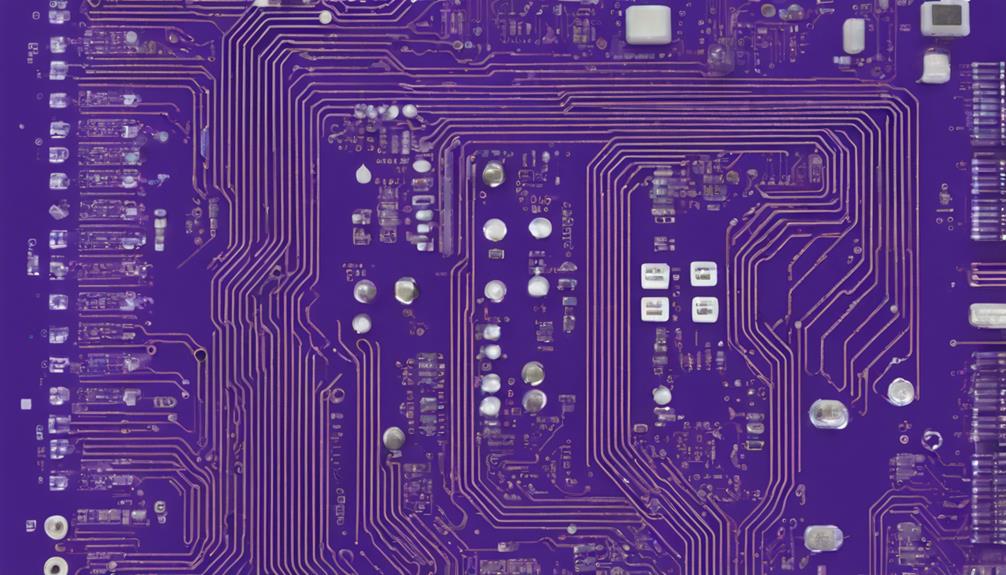
By leveraging advanced glass chemistry, AGC materials, such as Taconic and Nelco, achieve exceptionally high Tg values, surpassing those of standard FR4, to guarantee thermal stability in demanding applications. These materials are ideal for high-temperature applications where maintaining mechanical and electrical properties is essential.
AGC materials provide excellent thermal conductivity and low thermal expansion to prevent damage from thermal cycling.
Designers choose AGC materials for their superior performance under high heat conditions, ensuring the long-term reliability of electronic devices. Taconic and Nelco are commonly used in PCBs for aerospace, automotive, and industrial applications requiring reliable thermal management.
The high Tg values of AGC materials ensure that they can withstand extreme temperatures without compromising their thermal conductivity, making them an excellent choice for high-power applications. With their ability to maintain thermal stability, AGC materials are essential for ensuring the reliability and performance of electronic devices in demanding environments.
Arlon Materials for High Power PCBs
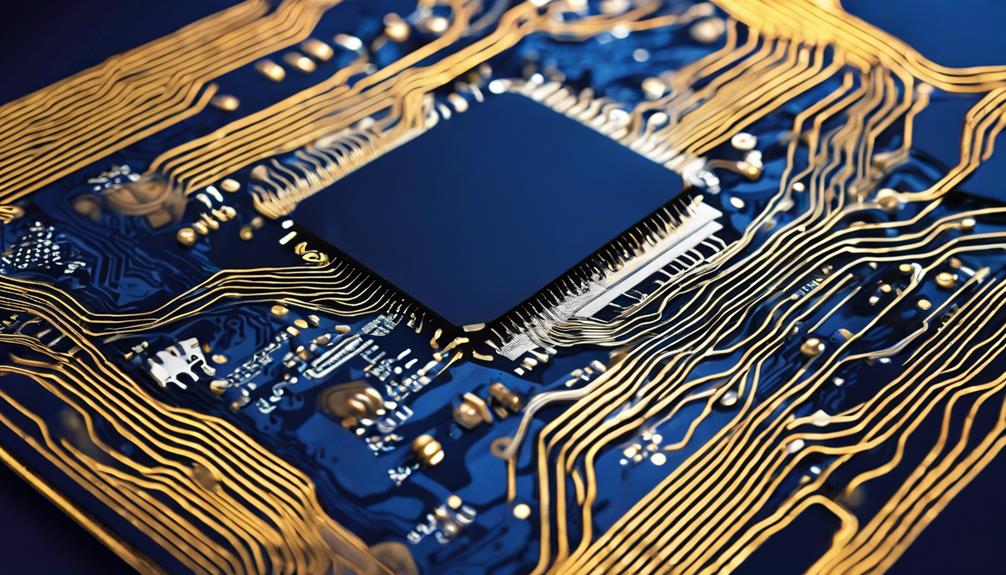
Arlon materials are engineered to excel in high-power PCB applications, where thermal management is critical. Specifically, their high-temperature insulation properties, low thermal resistance, and advanced thermal management capabilities make them an ideal choice for demanding designs.
High-Temperature Insulation Properties
Operating at extreme temperatures, high-power printed circuit boards (PCBs) require advanced insulation materials that can maintain reliable performance and withstand thermal stress. Arlon materials offer high-temperature insulation properties, making them an ideal choice for demanding applications.
Here are the key benefits of Arlon materials for high-power PCBs:
- High-Tg materials: Arlon's CuClad laminates boast glass conversion temperatures (Tg) up to 230°C, ensuring stable electrical performance and preventing delamination under heat.
- Excellent insulation properties: Arlon substrates provide reliable insulation, even in extreme temperatures, making them suitable for high-power PCBs.
- Thermal stress resistance: Designed to withstand high thermal stress, Arlon materials maintain their performance in demanding applications.
- Robust thermal management: Arlon's high-temperature insulation materials are ideal for applications requiring robust thermal management in PCBs.
- Reliable performance: With Arlon materials, you can expect reliable performance and minimal thermal degradation, even in the most challenging environments.
Low Thermal Resistance
In high-power printed circuit board (PCB) designs, materials with low thermal resistance are essential for efficient heat dissipation, and Arlon materials excel in this regard, offering exceptional thermal conductivity and stability.
By providing a low thermal resistance path, Arlon substrates enable efficient heat management, reducing the risk of thermal issues in electronic devices. These materials boast high thermal conductivity, making them ideal for high-power applications where heat generation is a significant concern.
Engineers often choose Arlon materials for their exceptional thermal properties in high-power circuit designs, where heat management is critical. By leveraging Arlon materials, designers can create reliable and efficient high-power PCBs that operate within a stable thermal envelope.
With their ability to dissipate heat efficiently, Arlon materials play an important role in maintaining the performance and longevity of high-power electronic devices. By selecting Arlon materials, designers can guarantee that their high-power PCB designs operate reliably, even in demanding environments.
Advanced Thermal Management
High-power printed circuit boards (PCBs) rely on advanced thermal management materials to mitigate the risks of overheating, and Arlon's innovative solutions excel in this domain. These advanced materials are designed to efficiently dissipate heat generated by high-power PCB components, ensuring excellent performance and reliability.
Arlon's advanced thermal management materials boast high thermal conductivity, allowing for effective heat dissipation and temperature control. This is essential in high-power PCB applications, where excessive heat can lead to component failure and reduced lifespan.
Key benefits of Arlon's materials include:
- High thermal conductivity for efficient heat dissipation
- Excellent thermal stability and reliability in demanding environments
- Ideal for applications requiring effective heat dissipation and temperature control
- Prevents overheating and maintains excellent performance
- Designed for high-power PCB applications where thermal management is critical
Polyimide Materials for Reliability
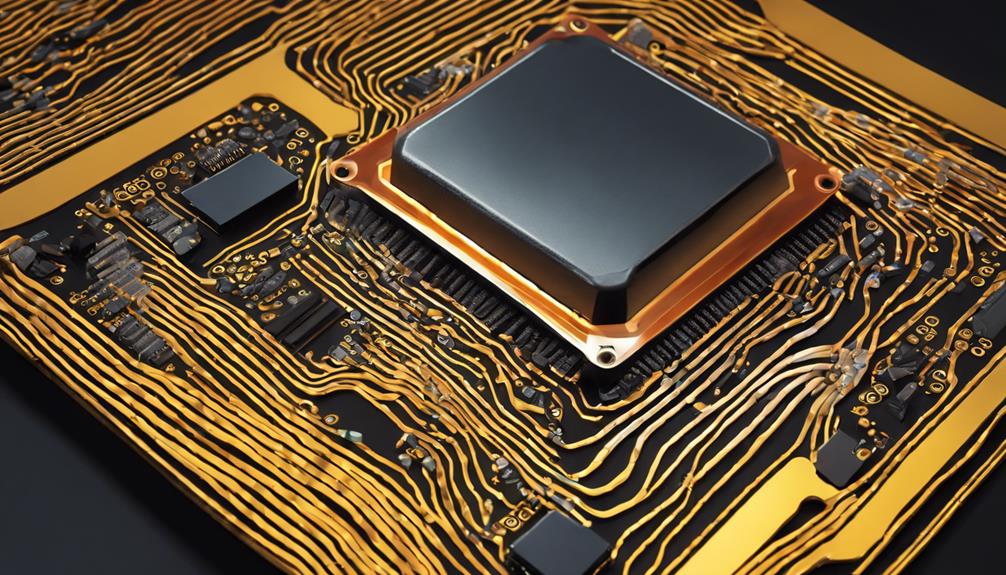
Polyimide materials have emerged as a reliable choice for thermal management in circuit boards, thanks to their exceptional thermal stability and mechanical properties that guarantee consistent performance in demanding environments. These materials exhibit high thermal stability, with a glass transformation temperature (Tg) exceeding 240°C, making them ideal for high-temperature applications.
| Property | Description |
|---|---|
| Thermal Stability | High Tg (>240°C) for reliable performance in high-temperature environments |
| Mechanical Properties | Excellent mechanical properties for consistent performance in demanding environments |
| Chemical Resistance | Good chemical resistance and low outgassing properties for harsh environments |
Polyimide films provide good chemical resistance and low outgassing properties, essential for electronic devices in harsh environments. Additionally, they exhibit low moisture absorption, maintaining electrical properties in humid conditions and preventing delamination. These benefits make polyimide substrates a popular choice for flexible PCBs, aerospace, automotive, and medical devices, where durability and critical performance are paramount. By leveraging polyimide materials, designers can create reliable and high-performance circuit boards that thrive in challenging environments.
High Temperature PCB Materials Guide
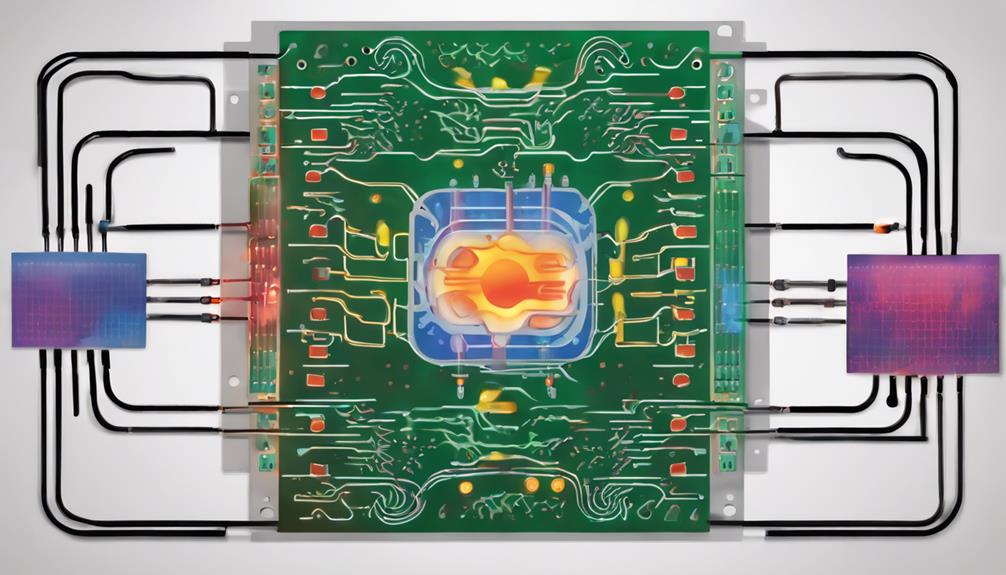
In high-temperature PCB applications, thermal resistance requirements are crucial to guarantee reliable operation and prevent overheating. Choosing materials with ideal thermal conductivity is essential to manage heat generation and dissipation.
This guide will explore the key considerations for high-temperature PCB materials, including thermal resistance requirements and the properties of suitable materials.
Thermal Resistance Requirements
When it comes to designing and manufacturing high-reliability circuit boards, selecting materials that meet stringent thermal resistance requirements is vital to guaranteeing top performance and preventing thermal runaway. High temperature PCB materials, such as PTFE-based laminates and Rogers, offer superior thermal resistance properties, making them ideal for demanding applications.
AGC materials like Taconic and Nelco also excel in high-temperature environments. Polyimide substrates are commonly used for their high-temperature capabilities in PCB applications.
To meet thermal resistance requirements, it is essential to take into account the following factors:
- Selecting materials with high glass stability temperatures (Tg) to ensure thermal stability
- Materials with optimized CTE values to minimize thermal expansion and contraction
- Implementing effective cooling strategies to dissipate heat efficiently
- Considering the frequency of temperature cycling to prevent material degradation
- Evaluating the thermal conductivity and diffusivity of materials to guarantee efficient heat transfer
High Temp PCB Materials
High temperature PCB materials, chosen for their exceptional thermal conductivity, electrical performance, and stability, are essential components in demanding applications where elevated temperatures are a norm. Materials like PTFE-based laminates, Rogers, AGC materials, Arlon, and Polyimide are commonly used for high temp PCB design, offering superior thermal conductivity and electrical performance.
The selection of high temp PCB materials is influenced by factors such as expected peak temperature, frequency of temperature cycling, cooling strategies, thermal conductivity requirements, and coefficient of thermal expansion (CTE) values. In high temperature PCBs, specialized materials like ceramics may be used for their superior thermal conductivity, while heavy copper layers can enhance heat dissipation.
It is important to choose materials with a glass transformation temperature (Tg) exceeding the expected operating temperature to guarantee the reliability and performance of high temperature printed circuit boards. By selecting the right high temperature PCB materials, designers can create reliable and efficient high temp PCB designs that can withstand demanding thermal conditions.
Thermal Interface Material Options
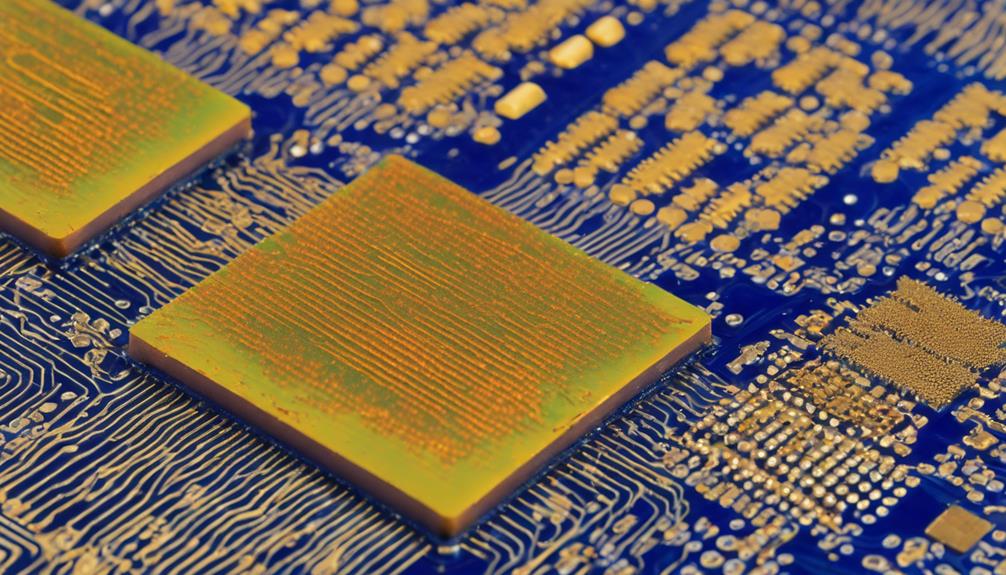
Selecting the ideal thermal interface material is essential for efficient heat dissipation in advanced electronic devices, as it directly impacts the overall performance and reliability of the circuit board. Thermal interface materials play a critical role in reducing thermal resistance and ensuring reliable heat transfer between devices and heat sinks.
When it comes to thermal interface material options, DuPont offers a range of high-performance solutions. Some of the notable options include:
- Thermally conductive silicones for advanced electronic heat dissipation
- Kapton MT and Kapton FMT films for high-reliability thermal management
- Temprion films and adhesive thermal tapes for efficient heat transfer
- Kapton MT+ films with superior thermal conductivity to reduce operating temperatures
- Thermal interface materials designed to withstand harsh conditions in electronic devices.
Metal Core Materials for Heat Dissipation

Beyond thermal interface materials, metal core materials emerge as a critical component in the thermal management of advanced electronic devices, offering superior thermal conductivity and efficient heat dissipation capabilities. In high-power applications, metal core materials such as Aluminum-backed PCBs are commonly used to prevent overheating, ensuring reliable performance and longevity.
The use of metal core materials like Aluminum improves the overall heat dissipation capabilities of the circuit board. By providing a direct path for heat transfer away from components, metal core PCBs reduce the risk of thermal damage. When compared to traditional FR4 PCBs, metal core materials excel in managing heat in demanding electronic designs.
| Material Property | Metal Core Materials |
|---|---|
| Thermal Conductivity | Superior to traditional FR4 PCBs |
| Heat Dissipation | Efficient and reliable |
| Application | High-power applications and LED lighting systems |
| Thermal Damage Risk | Reduced due to direct heat transfer path |
Metal core materials are essential for efficient heat dissipation in advanced electronics, making them a top choice for thermal management in high-performance applications.
Advanced Thermal Management Materials

As the demand for efficient thermal management in advanced electronics continues to grow, innovative materials with superior thermal conductivity and heat dissipation capabilities are being developed to meet the challenge.
Advanced thermal management materials are designed to provide excellent thermal performance, ensuring reliable operation of electronic devices.
Some notable examples of advanced thermal management materials include:
- DuPont's Temprion EIF, which boasts unparalleled thermal impedance for efficient heat transfer.
- Kapton MT and FMT films, offering high-performance thermal management in laminates for heat dissipation.
- Kapton MT+ films, featuring exceptional thermal conductivity properties to reduce operating temperatures and improve performance.
- Thermal interface materials, such as thermally conductive silicones, designed to effectively handle heat dissipation in electronic devices.
- Adhesive thermal tapes, like Temprion AT, which are pressure-sensitive and highly conformable for easy application.
These advanced materials are engineered to provide enhanced thermal conductivity, reduced thermal impedance, and improved heat dissipation, making them ideal for demanding electronic applications.
High Performance PCB Laminate Materials

High-performance PCB laminate materials have emerged as an essential component in the development of advanced electronic devices, offering unparalleled thermal impedance and heat transfer capabilities that surpass traditional materials.
DuPont's Temprion family, for instance, sets a new standard for thermal impedance and heat transfer, making it an ideal choice for demanding applications. Kapton materials, such as Kapton MT and Kapton FMT films, are also renowned for their high performance and reliability in managing heat, ensuring efficient thermal management in advanced electronic devices.
In addition to these, PTFE-based laminates, Rogers, AGC materials (Taconic, Nelco), Arlon, and Polyimide are commonly used for high-temperature PCB applications. When selecting PCB materials for high-temperature applications, factors such as expected peak temperature, frequency of temperature cycling, and CTE values of materials must be carefully considered.
Emerging Trends in Thermal Materials

In response to the escalating thermal management demands of modern electronics, innovative thermal materials have emerged to address the challenges of heat dissipation in advanced circuit boards.
The Temprion family by DuPont offers films and adhesive thermal tapes with unrivaled thermal impedance and high thermal conductivity. Kapton thermal management materials by DuPont provide high performance and reliability in heat management, with options like Kapton MT+ films reducing operating temperatures effectively. DuPont's thermal interface materials, such as thermally conductive silicones, are essential for handling heat dissipation in advanced electronic devices and applications.
Some emerging trends in thermal materials include:
- DuPont's Temprion family offering high thermal conductivity and low thermal impedance
- Kapton thermal management materials providing high performance and reliability in heat management
- Thermal interface materials like thermally conductive silicones for efficient heat dissipation
- Rolled foils and thick copper planes as heat sink elements in PCBs for reduced DC resistance
- Selection of PCB materials based on peak temperature, frequency of temperature cycling, and thermal conductivity requirements
Frequently Asked Questions
What Is the Best PCB Material for Heat Dissipation?
Like a conductor expertly guiding an orchestra, the ideal PCB material harmoniously balances thermal conductivity, coefficient of thermal expansion, and high-frequency performance.
When it comes to heat dissipation, the best PCB material is often a ceramic-based material, boasting exceptional thermal conductivity and low CTE.
This synergy enables efficient heat transfer, mitigating thermal stress and ensuring reliable performance in high-temperature environments.
How Do You Protect a Circuit Board From Heat?
To protect a circuit board from heat, a multi-faceted approach is necessary. Implementing thermal vias and heat sinks enhances heat dissipation.
Selecting materials with high thermal conductivity, such as ceramics or metal core PCBs, provides best heat protection. Additionally, choosing materials with high glass transformation temperatures (Tg) guarantees withstanding elevated operating temperatures.
What Are the Materials for High Temperature Pcb?
While conventional materials often buckle under extreme temperatures, high-temperature PCBs demand specialized materials that can withstand the heat. For high-reliability applications, PTFE-based laminates, Rogers, and AGC materials (such as Taconic and Nelco) are preferred for their thermal resilience.
Polyimide and Arlon materials also feature prominently, offering high thermal conductivity and minimal thermal expansion. These materials are carefully selected to guarantee ideal thermal performance, safeguarding the integrity of the circuit board.
What Materials Are Used for PCB Insulation?
For printed circuit board (PCB) insulation, various materials are employed to guarantee electrical isolation and thermal management. The most common materials used for PCB insulation include FR4, polyimide, PTFE, and ceramic laminates.
Each material offers unique properties, such as FR4's affordability, polyimide's thermal stability, PTFE's low dielectric loss, and ceramic's high thermal conductivity.
These materials are carefully selected based on the specific application requirements, ensuring excellent performance and reliability in diverse operating environments.


